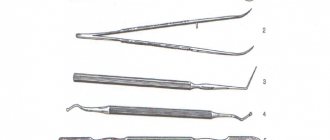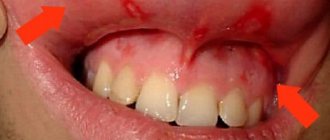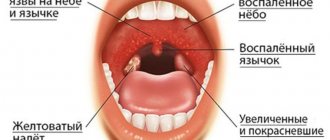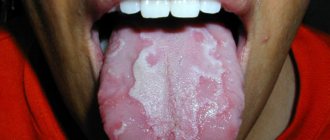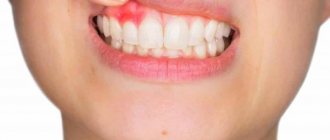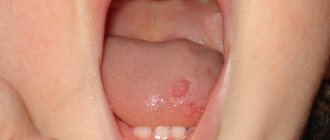Factors that have a negative impact on the mucous membrane:
- Uncontrolled use of potent drugs and antibiotics;
- Weakened immunity;
- Presence of AIDS, HIV;
- Inflammatory processes in the oral cavity;
- Damage to internal organs and systems;
- Poor nutrition;
- Alcoholism, smoking, drug addiction;
- Infectious diseases;
- Dehydration of the body;
- Avitaminosis;
- Hormonal imbalance;
- Hereditary predisposition.
Bacterial infections of the mouth
Streptococcal and staphylococcal infections of the oral cavity can cause the pathological changes discussed below.
Erosive stomatitis
This infectious lesion is caused by diplococci. In most cases, erosive stomatitis occurs in people who have had influenza, tonsillitis, or surgery.
Erosive inflammation of the mucous membrane of the hard and soft palate
The disease begins with the formation of clearly defined erythematous spots of a round shape. At the same time, the patient begins to feel itching and pain while eating.
Ulcerative-necrotizing stomatitis
This disease develops against the background of a systemic decrease in the level of human immunity. Experts believe that the causative agent of the disease is fusospiral infection.
Ulcerative-necrotizing stomatitis
This pathology is predominantly of moderate severity. At first, patients complained of a moderate rise in body temperature and severe soreness of the gums while eating and drinking.
Gangrenous stomatitis
The clinical picture of gangrenous inflammation of the oral mucosa is very severe. The patient suffers from a significant rise in body temperature due to severe intoxication of the body. On the side of the oral cavity, gradual detachment of the tents of the mucous membrane occurs.
Gangrenous stomatitis
Noma
A dental ulcer (noma) is a form of slowly progressing oral cancer.
The development of pathology, as a rule, is promoted by redness and ulceration of the oral mucosa. Subsequently, the deeper layers of the soft tissues of the oral cavity are involved in the inflammatory process.
Oral noma
Diphtheria
Medical instructions indicate that this infection is spread by airborne droplets. The causative agent in this case is the diphtheria bacillus.
The disease manifests itself in damage to the nasopharynx and palatine tonsils. On the part of the oral cavity, catarrhal inflammation of the mucous membrane is observed. The pathology poses a danger to the patient’s life due to progressive swelling of the palatine tonsils, which become covered with a gray-white coating.
Clinical signs of diphtheria
Scarlet fever
Scarlet fever, as an acute infectious lesion, develops as a result of the penetration of hemolytic streptococcus into the body. The pathogen spreads through the nasopharynx, involving regional lymph nodes in the pathological process.
Changes in the mucous membrane of the oral cavity during scarlet fever have a specific nature, which makes it possible to establish a diagnosis even before the detection of rashes on the skin.
Pinpoint rash with scarlet fever
The disease initially manifests itself as diffuse inflammation of the gums. And on the 2nd day, fine-grained rashes can be noticed on the mucous membrane of the hard palate. Then an inflammatory-purulent sore throat develops in the oral cavity against the background of enlarged lymph nodes.
Symptoms and their manifestation
Oral diseases can be diagnosed independently at home. It is only necessary to notice changes that have characteristic signs of a pathological process:
- The appearance of itching, burning or pain;
- Swelling;
- Formation of ulcers and pustules;
- Bleeding gums;
- Damage to tooth enamel;
- The appearance of an unpleasant odor;
- Weakness and sickness.
Important! There are some diseases that are completely asymptomatic in the first stages and only a specialist can notice this process. Therefore, it is recommended to visit the dentist every 6 months, even if nothing bothers you. A regular X-ray of the oral cavity will allow you to detect the decaying process in the oral cavity and begin treatment in a timely manner before the situation worsens and reaches a chronic stage.
Infectious and inflammatory processes
Infectious diseases of the oral cavity and tongue (photo below) include stomatitis. They are caused mainly by irregular and illiterate oral hygiene, and sometimes are a consequence of diseases of the gastrointestinal tract and some others (angina).
- stomatitis . The main symptom is swelling of the mucous membrane, accompanied by pain and a whitish or light yellow coating.
- Ulcerative. In this case, the mucous membrane is affected throughout its entire volume and depth. This is accompanied by swelling of the lymph nodes, dizziness and pain, general weakness and malaise. As a rule, this type occurs in patients with stomach or intestinal ulcers, enteritis.
Stomatitis is an infectious disease of the oral cavity - Aphthous . It is represented by erosive lesions of the mucous membrane and is characterized by foci of aphthae. Appears due to infection of the oral cavity, gastrointestinal imbalance, rheumatism. It may also be a consequence of allergies. The main symptoms: lethargy, hyperthermia and then the appearance of erosive ulcers.
Types of diseases
- Inflammatory;
- Infectious;
- Viral;
- Fungal.
Infectious viral processes:
- Catarrhal is a disease in which severe swelling and rashes appear, which are covered with a gray coating;
- Aphthous - the mucous membrane becomes covered with painful blisters, which burst over time, after which erosion forms in this place, which causes pain;
- Ulcerative – proceeds according to the catarrhal type.
Viral diseases
This category includes different types of stomatitis, which are more difficult to treat. Often these types of pathologies include infections caused by the herpes virus. It is localized near the oral cavity, but with weakened immunity it can spread to the oral mucosa.
Fungal
Diseases caused by infection with Candida fungi. This process often occurs in both childhood and adulthood.
Manifestations of common viral infections
Most viral diseases begin in the oral cavity, which serves as an entry point for viral particles. There are the following viral types of infections in the oral cavity:
Flu
This group of acute respiratory lesions is accompanied by redness and hyperemia of the mucous membrane of the gums and palate. These areas often develop fine-grained rashes, which are an early symptom of the flu.
Rashes due to influenza infection
Measles
The disease is spread by airborne droplets. A typical manifestation of measles in the oral cavity is bright red spots on the mucous membrane in the area of the chewing teeth. These elements rise slightly above the surface of the mucous membrane and are absolute evidence of measles.
Measles rash
Chicken pox
This viral disease begins acutely with hyperthermia and a rash on the skin. Along with external manifestations, a rash also forms in the oral cavity.
On the tongue, cheeks and palate, wind bubbles are not stable and will soon burst. Each new rash, as a rule, provokes another rise in body temperature.
Chicken pox
Infectious mononucleosis
Mononucleosis is transmitted by airborne droplets and contact. The clinical picture is characterized by three key symptoms:
- fever;
- angina;
- enlarged spleen.
On the part of the oral cavity, inflammation of the mucous membrane occurs, its redness. The doctor may also notice pinpoint hemorrhages in some places.
Infectious mononucleosis of the oral cavity
foot and mouth disease
This viral infection develops after the patient consumes infected dairy products and meat. Viral particles penetrate through damaged skin and the mucous membrane of the upper respiratory tract.
Symptoms of foot and mouth disease
The disease is characterized by an acute onset and intoxication of the body. On the third day, as a rule, blisters form on the mucous membrane, which end in the formation of inflammatory aphthae.
AIDS
The human immunodeficiency virus is transmitted in three main ways: sexual, contact and placental. HIV infection of the oral cavity is manifested by the activation of bacterial, fungal and viral infections, which is associated with a sharp inhibition of the protective properties of the body.
Such patients experience the following diseases:
- candidiasis of the mucous membranes;
- precancerous lesions in the form of hairy leukoplakia;
- severe forms of gingivitis and periodontitis;
- malignant and benign neoplasms of soft and hard tissues of the oral cavity.
Oral leukoplakia due to HIV infection
A typical sign of viral and bacterial lesions in AIDS is the ineffectiveness of etiotropic treatment.
The most common diseases of teeth and gums:
- Caries.
This is a common problem that affects almost every person at different ages. At the first stage of development, spots appear on the enamel, and as a result of development, hard tissues are destroyed;
- Gingivitis.
An inflammatory process that causes swelling and tenderness of the soft tissues. If treatment is not treated in a timely manner, the problem worsens and becomes chronic;
- Periodontitis.
A popular problem in which the initial stage is asymptomatic. Pain and discomfort appears after damage to bone and soft tissue;
- Periodontal disease
is expressed in periodontal damage, which can lead to tooth loss. Therefore, it is important to start treatment in a timely manner.
Causes of dry mucous membranes of the body
There are many factors that cause dryness in the mucous membranes of the mouth or nose. Let's look at each item in more detail.
So, most often, a lack of moisture in the mucous membranes occurs in the morning.
If you wake up every morning with insufficient fluid balance in the mucous membranes, you should pay attention to the humidity in the room and, if necessary, purchase a humidifier.
Typically, lack of moisture in your mouth or sinuses goes away some time after you wake up.
The main reason for this symptom is mechanical drying with air during sleep. The same reason includes snoring, a deviated nasal septum or a pathological structure of the nose.
If dryness appears not only in the morning, but also at night, you need to treat this problem with special attention. Perhaps dryness at night occurs due to large amounts of food taken before bed or in case of very dry air, as well as in case of inflammation of the nervous system.
It is known that in the dark the salivary glands stop working. If the functioning of the glands of the mucous membranes is disrupted, even more severe dryness occurs than in the daytime.
In addition to the cases described, the problem with the release of saliva or nasal mucus lies in the problem of the functioning of the abdominal cavity.
Dryness and lethargy
Other signs of dry mucous membranes include frequent alcohol consumption. Dryness in the nose and mouth almost always occurs after drinking alcohol.
However, lack of moisture can be caused by other symptoms. In this situation, it is necessary to correctly establish the symptoms and classification of inflammation and determine the real cause of the formation of this manifestation.
If dryness is accompanied by weakness and lethargy , an urgent examination is necessary. Since almost always these symptoms symbolize the beginning of the inflammatory process.
It is important to notice these signs in time and go to a qualified doctor. If you start treatment at this stage, you can detect the formation of dangerous diseases at an early stage and successfully treat them.
The combination of dryness, lethargy and weakness indicate diseases such as:
- The appearance of cancer cells.
- A painful state of the body due to poisoning with toxins with purulent discharge.
- Poisoning of the body with toxic substances.
- Inflammation of the nervous system.
- Inflammation of the body due to the penetration of viruses and bacteria.
- Blood cancer.
- Disease of the lymphatic tissue.
- Anemia.
Please note that if you have recently undergone surgery due to cancer, a lack of moisture in the mouth appears as a side effect after taking antibiotics or in the case of chemotherapy.
Dryness as a symptom of abdominal inflammation
If you are suffering from dryness not only in the sinuses, but also in the oral area, pay attention to the condition of the tongue.
In case of heavy plaque, it is necessary to check the condition of the abdominal cavity.
Often with this symptom, inflammatory processes occur in the stomach, intestines or esophagus.
This may indicate diseases such as:
- duodenal ulcer;
- stomach ulcer;
- gastroesophageal reflux inflammation;
- gastritis;
- colitis.
In case of strong white plaque and dryness in the oral area, it is necessary to conduct a comprehensive examination of the body, since in most cases these symptoms indicate the onset of a complex disease.
In addition to the listed diseases, the patient may be diagnosed with cholecystitis, appendicitis and other diseases that require urgent surgical intervention.
Bitterness and dryness
If insufficient hydration in the mucous membranes appears with a feeling of bitterness in the oral area, it is necessary to check the function of the biliary system, since the listed symptoms symbolize obvious dysfunction.
In addition, it is necessary to examine the functioning of the stomach and the secretion of hydrochloric acid or gastric juice. In this case, a violation of the excretion of bile occurs, which leads to stagnation of these products in the body.
Over time, they are absorbed into the blood, which negatively affects the work and quality of saliva.
In addition, the cause of bitterness and dryness can be dysfunction of the biliary system, inflammation of the gallbladder, disease of the gastric mucosa, and stomach ulcers.
Digestive system
When the mucous membranes are dry, nausea often occurs. This indicates that the body is poisoned by food products.
In some cases, the intestines should be checked, as intestinal viruses can also cause nausea. In this case, in addition to the described symptoms, vomiting and diarrhea occur.
In addition, dryness and nausea often occur in case of overeating or poor diet.
A doctor will help determine the exact cause, but first of all it is necessary to check the digestive system, since the symptom of dryness and nausea always indicates inflammation in this area.
Dizziness and dryness
If insufficient hydration in the sinuses and mouth is combined with dizziness, you should urgently go to a medical center, as these symptoms indicate a serious illness. In most cases, damage to the blood circulation occurs at this time .
In addition, dizziness and dry mucous membranes may be a sign of brain damage.
In this case, we are talking about dangerous inflammation, since if brain functions are impaired, a person cannot control balance. This causes nausea and vomiting, as well as disruption of the salivary glands.
Frequent visits to the restroom
If you suffer from insufficient moisture in the mouth and frequent urination, you should undergo a kidney examination, since the combination of these symptoms indicates kidney disease.
The processes of kidney inflammation cause dysfunction of the water balance in the body, since a person does not have time to fill the lack of fluid. At this time, a person feels constant thirst.
In addition, diabetes mellitus can be a reason for frequent visits to the restroom.
Dryness during pregnancy
Another cause of dryness can be a woman’s pregnancy. In this case, dry mouth or nose is not a permanent symptom.
However, in case of periodic or progressive lack of fluid and dryness, you should consult your doctor, as this sign may indicate the presence of an inflammatory process.
Prevention measures
By following simple rules you can reduce the likelihood of serious oral diseases:
- Brushing your teeth at least 2 times a day after eating;
- Using dental floss and mouthwash;
- Balanced diet;
- Rejection of bad habits;
- Visit the dentist at least once every six months;
- Active lifestyle.
Dentists note that many diseases in the first stages are asymptomatic. This is why it is important to visit a doctor regularly to detect the problem at an early stage and eliminate its cause without complications. It is important to have your teeth professionally cleaned at least once every few months. Such measures will help keep your mouth healthy for many years. It is especially important to monitor the condition of your teeth in old age. This is due to the fact that the body's immune system is weak and viruses develop very quickly.
Dysbacteriosis
This disease is precisely a consequence of the illiterate use of antibiotics, as well as the use of local antiseptics in the treatment of colds.
Symptoms of the disease at an early stage are practically invisible: bad breath, cracks in the corners of the lips. The development of the disease is accompanied by loosening of teeth and the appearance of associated ailments such as periodontal disease. Also, plaque is intensively formed on the teeth, corroding the enamel.
The appearance of cracks in the corners of the lips is a sign of dysbiosis
If the microflora of the oral mucosa is not restored in a timely manner, dysbacteriosis can cause damage to the receptors of the tongue, affecting the vocal cords and the function of the tonsils.
Above we looked at oral diseases in adults. Let's move on to diseases and pathologies of teeth and gums.
Timely treatment – quick recovery without consequences
When the first signs appear, you need to consult a doctor and choose the right treatment, which will be aimed at eliminating the root cause of the disease and its consequences.
This approach will help stop the development of further inflammatory process, avoid complications and get rid of painful sensations. Remember, your health is only in your hands, so remember it every day and spend time visiting competent specialists. This article is for informational purposes only, please consult your doctor for details! Ask your doctor about contraindications and side effects.
How to brush your teeth
Good hygiene is of great importance for older people. Retirees who have good oral care experience fewer dental problems. If necessary, teach your elderly relative how to care for their teeth and select suitable hygiene products for them.
Brushing your teeth should be done in the morning and evening. Cleansing lasts at least 3 minutes. It is better to choose a fluoride toothpaste: it restores the balance of minerals in teeth and reduces the risk of developing caries.
It is necessary to follow the correct technique for brushing teeth - from the gums to the cutting edges, to clean both the outer and inner surfaces. Hard-to-reach places and the space between teeth should be thoroughly cleaned.
It is important to take into account age-related characteristics: the gums shift, the necks of the teeth become exposed, and the distance between the teeth increases. For these reasons, teeth must be brushed carefully to avoid damage.
After cleaning, it is useful to use a rinse aid. Rinsing will prevent the development of caries and other dental problems, and eliminate bad breath. The mouthwash should be pleasant and not too spicy. You can choose the right one at a pharmacy or store (“Forest Balsam” and others).
In addition to brushing your teeth twice a day, it is recommended to use dental floss or a special brush at least once a day. These products will help you get rid of pieces of food between your teeth. Rinsing is also recommended after each meal.
Even if a person has no teeth, he needs to wash his mouth regularly to prevent dental problems. If you don’t have a rinse aid, you can use regular warm water with a small amount of salt dissolved in it. It is important to rinse your mouth thoroughly. The procedure can be performed before bed after brushing your teeth.


